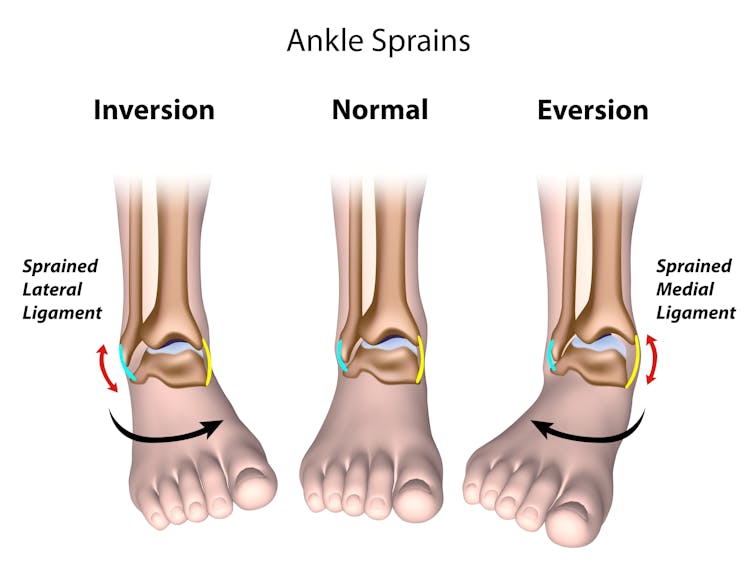Are you one of those people who seems to be forever spraining their ankle?
To some extent, ankle sprains are part and parcel of being active.
But if it’s happening again and again, here’s what may be going on – and how you can reduce your risk of recurrent ankle sprain.
Some people end up with what’s known as Chronic Ankle Instability, where they tend to re-sprain their ankle again and again. Shutterstock
One sprain can lead to another… and another
A large review of ankle sprain studies in the journal Sports Medicine found most people who actively play sport or train can expect to have a fairly low incidence of ankle sprain per 1,000 hours of training time. But it also said:
Females were at a higher risk of sustaining an ankle sprain compared with males and children compared with adolescents and adults, with indoor and court sports the highest risk activity.
The most frequent type of ankle sprain occurs if the ligaments on the outside of the ankle are stretched or torn when the joint moves beyond the normal range of movement. This is known as an inversion or lateral ankle sprain.
The most frequent type of ankle sprain occurs if the ligaments on the outside of the ankle are stretched or torn. Shutterstock
Strong evidence from studies suggests once people sprain their ankle, they are more likely to re-sprain it. As one review of the evidence put it:
a history of lateral ankle sprain is known to disrupt the structural integrity of the ligaments and sensorimotor function, likely impairing an individual’s ability to avoid injurious situations.
Some ankle sprains might seem to be very minor, with almost no swelling or mobility problems. But some people can end up with what’s known as chronic ankle instability, where they tend to re-sprain their ankle again and again.
Another review looking at factors contributing to chronic ankle instability found
feelings of instability and recurrent ankle sprain injuries (termed chronic ankle instability, or CAI) have been reported in up to 70% of patients. The subsequent development of CAI has adverse health consequences including reduced quality of life and early-onset osteoarthritis.
Once an ankle fracture is excluded, busy hospital emergency departments often send patients home with instructions to ice the ankle and keep off it for a day or two. There’s often no advice to follow up with a physio for rehabilitation.
This is unfortunate, as evidence suggests people with a history of ankle sprains will likely:
-
become progressively less active
-
have higher body mass indices
-
report more general body pain and
-
generally tend to have a lower quality of life.
Even the other ankle may be at risk
Research suggests people who sprain their ankle may be more likely to have injuries to other joints on the same leg, or even the opposite leg. A review in the International Journal of Sports Physiotherapy noted “an ankle sprain is linked to both re-injury and subsequent injury to the contralateral side”.
If you’re getting recurrent ankle sprains, see a physiotherapist. Photo by Kindel Media/Pexels, CC BY
Why? It may have something to do with the brain’s tremendous ability to continually adapt.
Just as extended bed rest or prolonged microgravity exposure in astronauts can cause changes in the brain and the way it relates to movement, perhaps our brains subconsciously compensate after an ankle injury.
That could be by, for example, via limping or a slight change in the way you walk; perhaps you subconsciously don’t want to challenge the ankle due to fear of re-spraining. This may put other joints or the opposite limb at heightened risk.
This neuroplasticity adds new challenges to the assessment or rehabilitation of ankle injury, and to predicting who is likely to be at increased risk of subsequent injuries.
What can you do to reduce the risk of re-spraining your ankle?
If you’re getting recurrent ankle sprains, see a physiotherapist. They will be able to teach you how to reduce the risk.
Currently the best evidence for reducing the chances of re-spraining your ankle sprain comes down to two main things:
1) Protecting the joint with an ankle brace when active
This could mean using a professionally fitted external support brace (not an elastic sleeve). This is a relatively low cost and effective means of risk reduction.
2) Using balancing exercises and ‘proprioceptive training’
Examples of proprioceptive training include:
-
balancing on each leg, one at a time, while throwing and catching a ball against a wall
-
balancing on an ankle disc or wobble board for three to five minutes daily.
Balancing exercises may help. Shutterstock
These exercises can help strengthen the muscles and ligaments in your ankle. As one literature review put it:
Proprioceptive training is a cost- and time-effective intervention that can benefit patients who have sustained a previous ankle sprain during physical activity and can subsequently reduce the risk of further complications.



 U.S. Backs Bayer in Supreme Court Battle Over Roundup Cancer Lawsuits
U.S. Backs Bayer in Supreme Court Battle Over Roundup Cancer Lawsuits  Pfizer Boosts Bid for Metsera Amid Intensifying Rivalry with Novo Nordisk in Obesity Drug Market
Pfizer Boosts Bid for Metsera Amid Intensifying Rivalry with Novo Nordisk in Obesity Drug Market  Trump Signs Executive Order to Boost AI Research in Childhood Cancer
Trump Signs Executive Order to Boost AI Research in Childhood Cancer  U.S. Experts to Reassess Newborn Hepatitis B Vaccination Guidelines Amid Growing Debate
U.S. Experts to Reassess Newborn Hepatitis B Vaccination Guidelines Amid Growing Debate  Eli Lilly’s Weight-Loss Pill Nears Fast-Track FDA Approval as Profits Surge on Global Demand
Eli Lilly’s Weight-Loss Pill Nears Fast-Track FDA Approval as Profits Surge on Global Demand  California Jury Awards $40 Million in Johnson & Johnson Talc Cancer Lawsuit
California Jury Awards $40 Million in Johnson & Johnson Talc Cancer Lawsuit  U.S. and Rwanda Sign $228 Million Health Partnership to Boost Self-Reliance
U.S. and Rwanda Sign $228 Million Health Partnership to Boost Self-Reliance  Major Drugmakers Slash U.S. Prices and Sell Directly to Patients Amid Trump’s Push for Affordable Medicines
Major Drugmakers Slash U.S. Prices and Sell Directly to Patients Amid Trump’s Push for Affordable Medicines  Novo Nordisk Appoints Greg Miley as Global Head of Corporate Affairs Amid U.S. Pricing Pressure
Novo Nordisk Appoints Greg Miley as Global Head of Corporate Affairs Amid U.S. Pricing Pressure  Pfizer Sues Novo Nordisk Over Alleged Tactics to Block Obesity Drug Competition
Pfizer Sues Novo Nordisk Over Alleged Tactics to Block Obesity Drug Competition  Obamacare Premiums Set to Double in 2026 as Subsidy Expiration Looms Amid U.S. Shutdown
Obamacare Premiums Set to Double in 2026 as Subsidy Expiration Looms Amid U.S. Shutdown  Eli Lilly Becomes First Pharma Giant to Hit $1 Trillion Amid Soaring Weight-Loss Drug Demand
Eli Lilly Becomes First Pharma Giant to Hit $1 Trillion Amid Soaring Weight-Loss Drug Demand  Canada Loses Measles-Free Status After Nearly 30 Years Amid Declining Vaccination Rates
Canada Loses Measles-Free Status After Nearly 30 Years Amid Declining Vaccination Rates  FDA Adds Fatal Risk Warning to J&J and Legend Biotech’s Carvykti Cancer Therapy
FDA Adds Fatal Risk Warning to J&J and Legend Biotech’s Carvykti Cancer Therapy  Novo Nordisk and Eli Lilly Lower Prices for Weight-Loss Drugs Amid U.S. Agreement
Novo Nordisk and Eli Lilly Lower Prices for Weight-Loss Drugs Amid U.S. Agreement 




































